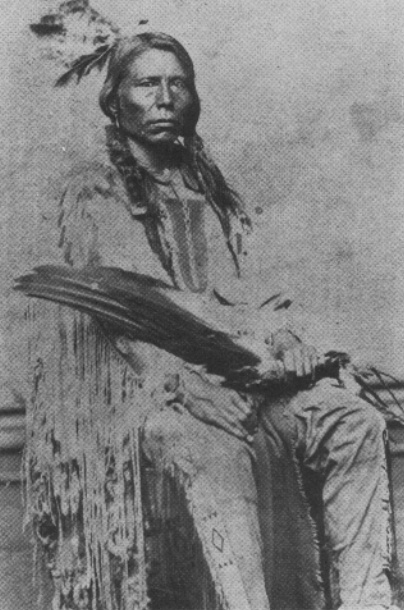 Photo attributed to Crazy Horse
Photo attributed to Crazy Horse

Tashunca-uitco
(1849-1877)
Celebrated for his ferocity in battle, Crazy Horse was recognized
among his own people as a visionary leader committed to preserving the
traditions and values of the Lakota way of life.
Even as a young man, Crazy Horse was a legendary warrior. He stole horses
from the Crow Indians before he was thirteen, and led his first war party
before turning twenty. Crazy Horse fought in the 1865-68 war led by the
Oglala chief
Red Cloud against American
settlers in Wyoming, and played a key role in destroying William J. Fetterman's
brigade at
Fort Phil
Kearny in 1867.
Crazy Horse earned his reputation among the Lakota not only by his skill
and daring in battle but also by his fierce determination to preserve
his people's traditional way of life. He refused, for example, to allow
any photographs to be taken of him. And he fought to prevent American
encroachment on Lakota lands following the
Fort
Laramie Treaty of
1868, helping
to attack a surveying party sent into the Black Hills by General
George
Armstrong Custer in 1873.
When the War Department ordered all Lakota bands onto their reservations
in
1876, Crazy Horse became a
leader of the resistance. Closely allied to the Cheyenne through his first
marriage to a Cheyenne woman, he gathered a force of 1,200 Oglala and
Cheyenne at his village and turned back General
George
Crook on June 17, 1876, as Crook tried to advance up
Rosebud
Creek toward
Sitting Bull's
encampment on the
Little
Bighorn. After this victory, Crazy Horse joined forces with Sitting
Bull and on June 25 led his band in the counterattack that destroyed Custer's
Seventh Cavalry, flanking the Americans from the north and west as Hunkpapa
warriors led by chief
Gall charged from
the south and east.
Following the Lakota victory at the Little Bighorn, Sitting Bull and
Gall retreated to Canada, but Crazy Horse remained to battle General
Nelson
Miles as he pursued the Lakota and their allies relentlessly throughout
the winter of 1876-77. This constant military harassment and the decline
of the buffalo population eventually forced Crazy Horse to surrender on
May 6, 1877; except for Gall and Sitting Bull, he was the last important
chief to yield.
Even in defeat, Crazy Horse remained an independent spirit, and in
September 1877, when he left the reservation without authorization, to
take his sick wife to her parents, General George Crook ordered him
arrested, fearing that he was plotting a return to battle. Crazy Horse
did not resist arrest at first, but when he realized that he was being
led to a guardhouse, he began to struggle, and while his arms were held
by one of the arresting officers, a soldier ran him through with a
bayonet.
Link:
http://www.pbs.org/weta/thewest/people/a_c/crazyhorse.htm

